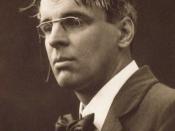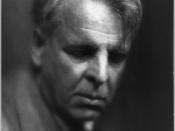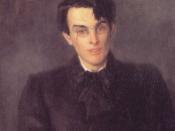William Butler Yeats can be described as one of the last romantics, despite broadening his style later in life to include some of the new modernist techniques and ideas. A man of deep respect for ceremony, Yeats maintained his passion for rhyme and meter throughout his life, and this appreciation of form kept him from jumping headlong into the realm of modernism. His poetry begins as highly romantic, fearful and introverted, but as Yeats matures, his poetry gains a tone of acceptance and broader perspective that includes the rest of civilization--not to mention a more modern, minimalist style.
Adorned with vivid language and lush imagery, Yeats' early poems are characterized by a sort of fearful tunnel vision that focuses on only his own emotional life and Irish mythology. These early poems are highly structured, typically carrying a rather sing-songy meter, and tend to revolve around themes that contrast a harsh reality with a faery land to which Yeats yearns to escape.
The reality versus fairy land theme in this early period of his career is just one incarnation of the common theme of antitheses throughout Yeats' career. These antitheses are a part of his belief system, as described in "A Vision," which (very simplified) states that everything works in cycles. Using gyres as symbols for the cyclic habits of nature (such as patterns of growth and decay, waxing and waning, etc.), Yeats basic theory was that everything needed an antithesis to be complete, and that everything moved in a cycle between one opposite to the other, like a pendulum of sorts.
As can be seen in "The Stolen Child", Yeats held a fear of the pain and toils of reality that led him to yearn for a romantic escape. The child symbolizes an innocence that Yeats cannot find...


